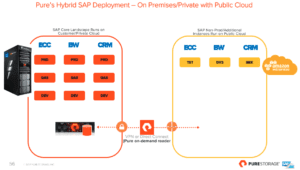This post was originally posted here.
Running apps in public cloud is great for certain applications, but running mission critical applications in public cloud is a whole different story. Much ink has been spilled on this topic so I will be brief. The relationship between the IT department and their ERP applications is the longest of any application. The application grows quickly with the company, its tentacles start reaching far and beyond what it was initially built for. Public cloud is great to get started easily and cheaply but at a certain point, the economics as to why public cloud was chosen stop making sense. When it comes to mission critical applications, a hybrid cloud strategy starts making more sense.
I’ll be honest, the phrase Hybrid Cloud is one of my pet peeves and most hated phrases in IT. Yet it is one of the most used and least-understood ones. Hybrid doesn’t mean you run something in public cloud, another thing in private cloud and now you are running hybrid. Having a private cloud for ERP and SaaS for HR doesn’t mean you run hybrid. REAL Hybrid means you are enabling the SAME application team, IT and business, to take advantage of different deployment types. It means enabling the SAP team who administrates SAP in a private cloud to spin non-Prod instances in AWS as the business, projects and resources demand. Keeping your core tiers (e.g. PRD, QAS, DEV1, DEV2, TST) in the most optimized shape (performance, security, control, SLA, etc.) is a priority.

However, running a temporary non-prod instance the business needs for a month or two isn’t critical. You don’t care about getting the best performance, you just have to spin it quickly so the business can start using it. With Pure’s data platform, we are enabling a REAL hybrid environment that allows running SAP applications on-prem/private cloud where you gain the performance and control you require, and still spin SAP instances quickly and easily in public cloud, such as AWS (Azure and GCP support later next year). This is based on our new CloudSnap technology where you can migrate workloads to run natively in the cloud.. The use case where are about to discuss is slated for 2018 as CloudSnap matures and will likely evolve in functionality as we work closely with customers.

This gives SAP administrates and SAP shops truly the best of both worlds and a real, secure hybrid cloud strategy. Something no one in the industry can do with this simplicity and cost. There is no extra software or gateway required. You are not locked-in to a certain model. Taking advantage of the public cloud for SAP workloads doesn’t have to be a costly multi-year venture anymore or an all-or-nothing proposition .
We just introduced CAT for SAP, our free system-copy tool to refresh test systems with production data. Next we will be integrating SnapClone and CAT to ship non-prod SAP workloads to the cloud. This will breakdown the boundaries between different SAP clouds and give customers the freedom to run different SAP instances the way they and their business desire.

Join us on December 6th for a webinar to discuss multi-cloud strategies for SAP and go in detail how this all works. Register here.



